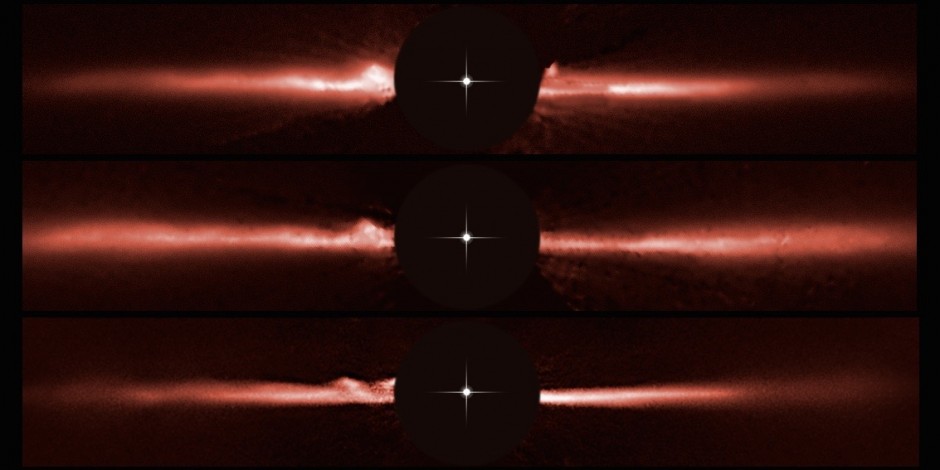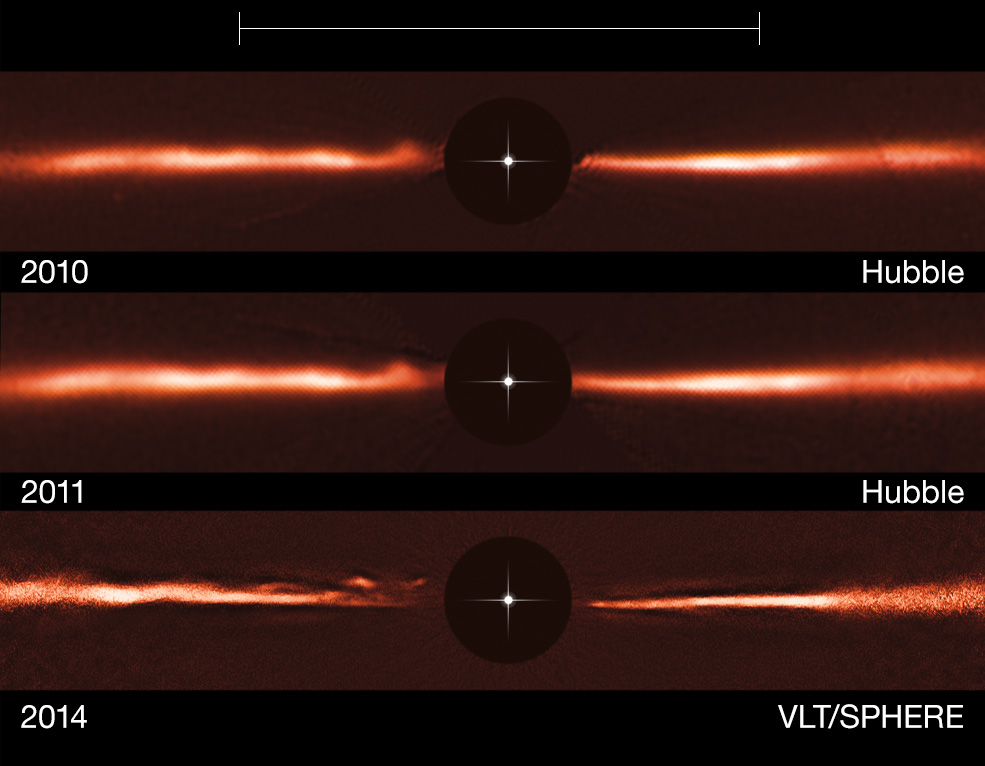Mysterious structures

A research team has observed structures racing out from the centre of a young star’s debris disk at high speeds. “It looks as if someone had smudged a freshly painted picture into a wavy line with their finger,” says ETH astrophysicist Christian Thalmann.
“We were speechless when we saw the image for the first time in the control room at the observatory in Chile,” remembers Christian Thalmann of the Institute for Astronomy at ETH Zurich, who is also a member of the National Centre of Competence in Research PlanetS and a Marie Curie fellow. Together with a team of international colleagues, he was using the European Southern Observatory’s (ESO) Very Large Telescope (VLT) to observe the celestial object AU Microscopii, a young star in our cosmic neighbourhood that is “only” 23 light years away. Astronomers have known for years that AU Mic is surrounded by a debris disk. Now, however, a newly installed instrument named SPHERE has allowed them to resolve the inner part of the disk clearly for the first time.

The top row shows a Hubble image of the AU Mic disc from 2010, the middle row Hubble from 2011 and the bottom row is an image taken with the SPHERE instrument, mounted on the Very Large Telescope, from 2014. The black central circles show where the brilliant light of the central star has been blocked off to reveal the much fainter disc, and the position of the star is indicated schematically. (Credit: ESO, NASA & ESA)
The astonishing image showed five bow-like structures at different distances from the star, much like waves on the surface of a body of water. “No one had expected to find such well-defined, long-ranged and detailed structures,” says Christian Thalmann: “At first, some members of the team thought the observation must have been jittered by accident.”
Tremendous speed
The researchers were even more surprised when they compared the new images with data obtained using the Hubble Space Telescope in 2010 and 2011. The older images already hinted at some of the wavy or bow-like structures. “We therefore contacted the authors of that study and processed their data again together,” recalls the ETH researcher. This allowed the team to trace the structures’ development back over a period of five years. The result: the bows are moving outwards from the star at unexpectedly high speeds of up to 40,000 kilometres per hour. As the international team under lead author Anthony Boccaletti reports in Nature, the structures cannot be bound on closed orbits around AU Mic, but rather are being ejected from the system altogether.
“We still don’t know what phenomenon we’re observing here or what causes it,” says Christian Thalmann. Key factors could include a previously undiscovered planet or the fact that AU Mic is an exceptionally active star. It is generally assumed that debris disks such as the one surrounding AU Mic originate from an ‘asteroid belt’, in which colliding rocks grind each other down into ever-finer debris. The fine dust created in this process is blown outwards by the stellar wind, forming an expansive disk. “My assumption is now that a planet has bent the asteroid belt into an irregular shape causing some of the collisions to take place above or below the disk plane,” explains the ETH researcher. “If particularly powerful outbursts from the star’s atmosphere impact on these parts of the asteroid belt, they could pick up large amounts of collision dust and carry them away. We would then be able to observe these as localised structures above the disk plane.”
In order to understand this mysterious phenomenon, the researchers intend to monitor the structures’ subsequent movement and development through regular follow-up observations, and to obtain further information on the spatial arrangement and chemical composition of the dust. “And, of course, if a previously undiscovered planet should be part of the puzzle, we also hope to find it,” says Christian Thalmann.
Literature reference:
Anthony Boccaletti, Christian Thalmann, et al.: “Fast-Moving Structures in the Debris Disk Around AU Microscopii”, Nature, 8 October 2015.
http://nature.com/articles/doi:10.1038/nature15705
Categories: News

